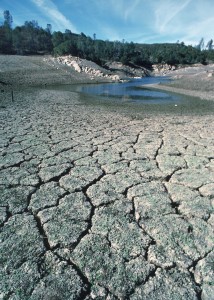 Several recent events have drawn national attention to something Westerners deal with all the time – water. We have always known that problems of both water supply and water quality can affect millions of lives and cost billions of dollars. Water is usually not the hottest topic in politics, but the record-breaking drought in California, severe floods in Texas, and the drinking water crisis in Flint, Michigan all became national news and highlighted problems with our water infrastructure.
Several recent events have drawn national attention to something Westerners deal with all the time – water. We have always known that problems of both water supply and water quality can affect millions of lives and cost billions of dollars. Water is usually not the hottest topic in politics, but the record-breaking drought in California, severe floods in Texas, and the drinking water crisis in Flint, Michigan all became national news and highlighted problems with our water infrastructure.
Perhaps coincidentally, this created perfect timing for another major White House conference, held in March on “World Water Day,” a part of “Agenda 21” that came out of the 1992 UN Conference on Environment and Development in Rio de Janeiro.
A key theme of this year’s World Water Day, and the corresponding White House conference, was about the connection between water resources and jobs. The White House pointed out that these major water events hurt minorities and the poor most, and centered much of the conference agenda on the impact of global warming on water resources. While water leaders in Colorado spent the last ten years laboring through the details to create a serious statewide water plan, our national leaders are doing their part, holding meetings to figure out whether they have any role to play at all.
Here are several highlights of the White House Water Summit, quoted directly from the White House press release: we must “work together to build a sustainable water future;” we will “shine a spotlight on the importance of cross-cutting, creative solutions;” we will “highlight innovative strategies;” and we need to “catalyze change.” The word “sustainable” was used four times in one press release. All this means simply that everyone should have safe, clean, and affordable water. But there are lots of lawyers in Washington, so they try never to use one word when five will do just as well.
These federal efforts must be serious. After all, they resulted in a “Presidential Memorandum,” which was followed up last December by a “Long-Term Federal Action Plan.” Apparently, “more than 150 external institutions joined the federal government in announcing new efforts and commitments to enhance the sustainability of water in the United States by managing our water resources and infrastructure for the long term.” Really? Not to overstate the obvious, but all water planning is long-term. Generations of Westerners invested in water infrastructure designed to help survive the droughts by storing water during wet periods. That is long-term planning. And the Colorado pioneers who worked on such projects for generations did so without the obvious benefits of either a White House conference or a World Water Day.
The White House says this is about taking steps to accelerate development, demonstration, and deployment of innovative technologies, supporting critical research, enhancing data collection, conserving water, raising public awareness, and delivering tools and technologies. It strikes me as being about almost everything but water. These activities are really more about meetings, studies, and regulations – now the primary role of a government that once built water projects.
The conference did highlight almost $5 billion worth of investments by the private sector – in actual water infrastructure projects, and in research and development of new technologies for water supply, wastewater, and reuse. And predictably, the Administration announced another $35 million in grants from the Environmental Protection Agency, National Oceanic and Atmospheric Administration, National Science Foundation, and Department of Agriculture to fund more studies. Mark my words, such studies will eventually result in new federal regulations, too.
The whole discussion is fascinating to Westerners, most of whom understand that water is already one of the most “sustainable” things on the planet – in the sense that there is a finite amount, and it moves in and out of the atmosphere, rivers, and oceans in natural cycles over which mankind has almost no control. The conversation we need about water is how to store more of it during wet periods for use during dry periods, and how to maintain its pristine quality while moving it from place to place. Those are serious challenges for leaders, and should not be used to drive political agendas, on global warming or anything else. It might be helpful if the federal government focused such attention on the actual need for more water supply in the arid west.
But for now, our government will “continue to carefully examine and take action in areas where further effort is needed to protect our Nation’s water resources and build a sustainable water future.” Feel better?
A version of this column originally appeared in the Grand Junction Daily Sentinel March 25, 2016




Comments on this entry are closed.